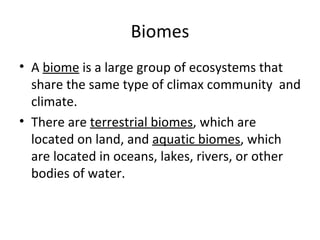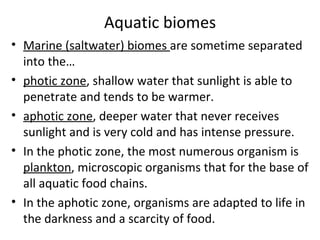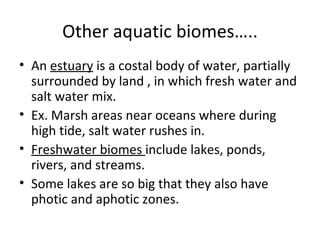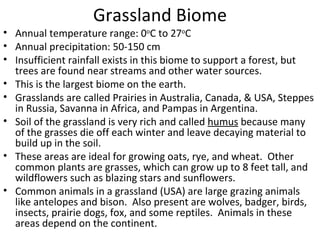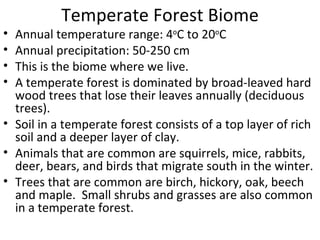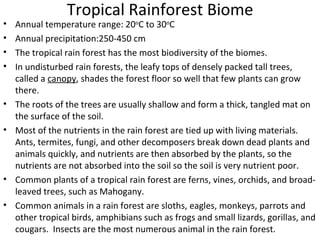Biomes
- 1. Biomes
- 2. Biomes A biome is a large group of ecosystems that share the same type of climax community and climate. There are terrestrial biomes , which are located on land, and aquatic biomes , which are located in oceans, lakes, rivers, or other bodies of water.
- 3. Aquatic biomes Marine (saltwater) biomes are sometime separated into the… photic zone , shallow water that sunlight is able to penetrate and tends to be warmer. aphotic zone , deeper water that never receives sunlight and is very cold and has intense pressure. In the photic zone, the most numerous organism is plankton , microscopic organisms that for the base of all aquatic food chains. In the aphotic zone, organisms are adapted to life in the darkness and a scarcity of food.
- 4. Other aquatic biomes….. An estuary is a costal body of water, partially surrounded by land , in which fresh water and salt water mix. Ex. Marsh areas near oceans where during high tide, salt water rushes in. Freshwater biomes include lakes, ponds, rivers, and streams. Some lakes are so big that they also have photic and aphotic zones.
- 5. Bell work Compare terrestrial biomes to aquatic biomes. Explain the differences between the photic zone and the aphotic zone in an aquatic biome. Explain how sometimes estuaries have more salt water (higher salt content) than other times.
- 6. Terrestrial biomes 2 abiotic factors influence the kind of climax community that develops. Temperature Precipitation
- 7. Tundra Biome Average temperature: -15 o C to 0 o C Annual precipitation: 10-100 cm Temperatures in the tundra rarely rise above freezing so only the top layer of soil thaws during the summer, creating a swampy area where insects lay eggs. Underneath the topsoil is a layer of permanently frozen ground called permafrost . The soil in the tundra has little nutrients and is very thin and can only support shallow rooted grasses and other small plants. Common plants include grasses, dwarf shrubs, reindeer moss, small annuals, and cushion plants. Mosquitoes and other biting insects are common in the summer months. Common animals are lemmings, weasels, arctic foxes, snowshoe hares, showy owls, hawks, and some musk oxen, caribou, and reindeer during the summer.
- 8. Taiga Biome Annual temperature range: -5 o C to 7 o C Annual precipitation: 25 -200 cm Just south of the tundra lays the taiga . The soil in the taiga is acidic and does not contain many minerals. The soil has a dense covering of decaying pine needles. Common plants include many coniferous trees such as pine, fir, spruce, and hemlock along with small shrubs and grasses. The many trees provide more food and shelter for animals than in the tundra. Common animals are moose, elk, bears, lynx, snowshoe hare, caribou, owls, eagles, squirrels, rabbits, and small rodents.
- 9. Desert Biome Annual temperature range: 0 o C to 30 o C Annual precipitation: 0-50 cm The soil is mostly sand, which does not hold moisture for the plants that grow there. Common plants that grow in the desert are small shrubs, mesquite trees, cactus, and creosote bushes. Many desert plants have spines, thorns, or poisons that act to discourage heterotrophs from eating them. Other desert plants have thick waxy coatings on their leaves to reduce transpiration. Most animals that live in the desert remain under cover during the heat of the day and come out at night to find food. Common animals are the lizard, tortoise, snakes, scorpions, rodents, foxes, coyote, hawks, owls, and roadrunners.
- 10. Grassland Biome Annual temperature range: 0 o C to 27 o C Annual precipitation: 50-150 cm Insufficient rainfall exists in this biome to support a forest, but trees are found near streams and other water sources. This is the largest biome on the earth. Grasslands are called Prairies in Australia, Canada, & USA, Steppes in Russia, Savanna in Africa, and Pampas in Argentina. Soil of the grassland is very rich and called humus because many of the grasses die off each winter and leave decaying material to build up in the soil. These areas are ideal for growing oats, rye, and wheat. Other common plants are grasses, which can grow up to 8 feet tall, and wildflowers such as blazing stars and sunflowers. Common animals in a grassland (USA) are large grazing animals like antelopes and bison. Also present are wolves, badger, birds, insects, prairie dogs, fox, and some reptiles. Animals in these areas depend on the continent.
- 11. Bell Work If you were lost in a desert, what time of day would you travel and why? Explain why there are not many trees in a grassland. If you are traveling south (from the north pole), how would you know that you have moved from the tundra into the taiga? What is the main abiotic limiting factor for a desert?
- 12. Temperate Forest Biome Annual temperature range: 4 o C to 20 o C Annual precipitation: 50-250 cm This is the biome where we live. A temperate forest is dominated by broad-leaved hard wood trees that lose their leaves annually (deciduous trees). Soil in a temperate forest consists of a top layer of rich soil and a deeper layer of clay. Animals that are common are squirrels, mice, rabbits, deer, bears, and birds that migrate south in the winter. Trees that are common are birch, hickory, oak, beech and maple. Small shrubs and grasses are also common in a temperate forest.
- 13. Tropical Rainforest Biome Annual temperature range: 20 o C to 30 o C Annual precipitation:250-450 cm The tropical rain forest has the most biodiversity of the biomes. In undisturbed rain forests, the leafy tops of densely packed tall trees, called a canopy , shades the forest floor so well that few plants can grow there. The roots of the trees are usually shallow and form a thick, tangled mat on the surface of the soil. Most of the nutrients in the rain forest are tied up with living materials. Ants, termites, fungi, and other decomposers break down dead plants and animals quickly, and nutrients are then absorbed by the plants, so the nutrients are not absorbed into the soil so the soil is very nutrient poor. Common plants of a tropical rain forest are ferns, vines, orchids, and broad-leaved trees, such as Mahogany. Common animals in a rain forest are sloths, eagles, monkeys, parrots and other tropical birds, amphibians such as frogs and small lizards, gorillas, and cougars. Insects are the most numerous animal in the rain forest.
- 14. Bell Work Explain how you could distinguish a tropical rain forest from a temperate forest. Explain why when trees are cut down in a tropical rain forest that it is nearly impossible to get other plants to grow again there. Explain why there are areas in the tropical rainforest biome that are experiencing drought conditions. Explain why it is unethical to purchase Mahogany furniture.
- 15. Climatograph You will graph the temperature and precipitation for a set of data and use it to determine what biome the data is for. You will graph temperature and precipitation on the SAME graph. Make sure you label each graph fully, including biome letter. The month will be the x-axis. The temperature will be on the left y-axis and will be a bar graph. The precipitation will be on the right y-axis and will be a line graph. Once you finish with the 4 graphs, you will answer the questions for each data set.

